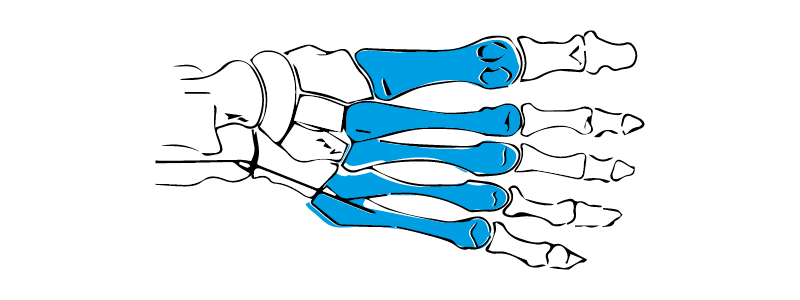
Lesser Metatarsal Osteotomy
What is a lesser metatarsal osteotomy?
The metatarsal bones are the long bones that extend from your toes into your foot (see picture below). The lesser metatarsals are the bones behind the 2nd, 3rd, 4th and 5th toes. The word osteotomy means to “cut through bone”, so a lesser metatarsal osteotomy is when cuts are made to one or more of the lesser metatarsal bones. The cuts are often fixed back together with pins, screws or plates. Sometimes cuts to bone are made and no fixation is required.

Why is a lesser metatarsal osteotomy performed?
The aim of surgery is to improve the position of the bone and reduce pain in the forefoot. Some people have metatarsal bones that are too long or that are plantarflexed (angled downwards). This can sometimes cause increased pressure under the foot and lead to painful corns and callus. Shortening or lifting the metatarsal bone can help address this. Sometimes a toe may have drifted to one side or another or dislocated from the joint. A metatarsal osteotomy can be performed to help address this. A lesser metatarsal osteotomy can also be performed to address a bunion on the outside edge of the foot (a Tailor’s Bunion or Bunionette).
What are the alternatives to surgery?
You may want to avoid surgery or try all the alternatives first. Non-surgical options to help reduce pain in the forefoot include:
- Changing footwear to a style with a fastening and thick, soft, spongy sole i.e. a good quality trainer.
- Wearing pads to cushion the area.
- Putting insoles in your shoes to help redistribute pressures – ask for more information on whether you can be referred for these.
- Attend a podiatrist for regular reduction of corns and callus.
- Steroid injections may be indicated in some circumstances e.g. if the toe joint is inflamed – ask your clinician for further information on this.
What are the risks of surgery?
General surgical risks
- Infection
- Blood clots
- Chronic pain
- Painful/ thickened scarring
- Numbness
- Bleeding
- Swelling
Specific risks of lesser metatarsal osteotomy
- The need to remove the fixation i.e. pins, screws or plates
- A failure for the bone to heal - delayed or non-union of bone.
- Transfer of a skin lesion (corn or callus) to another area of the forefoot.
- The need to shorten or lift other metatarsal bones at a later date e.g. in the case of transfer of skin lesions.
What does the operation involve?
This procedure can be performed as a day case operation, using either general or local anaesthetic. If done using local anaesthetic, you can eat and drink as normal. You will have a small skin incision followed by some stitches and a dressing to cover the wound. You do not usually need to have a plaster cast. You will have a post-operative shoe and crutches. You must have a responsible adult at home to support you afterwards.
What will happen after the surgery?
1-3 days
- The first 1-3 days are the most uncomfortable.
- You will receive advice on how to manage pain and will be told how to take painkillers.
- You should spend a restful few days with your foot elevated as much as possible.
- You should drink plenty of fluid and move around the home to fetch refreshments and use the toilet.
- You will usually be able to weight-bear on the foot using your shoe and crutches, unless you’ve been advised otherwise. If you do too much at this stage, the foot will swell and become painful.
- It may bleed and your risk of infection is increased.
2 weeks
- Around 2 weeks following surgery, you will have your dressing changed and stitches removed.
- You can usually bathe again once stitches are removed and start to gradually increase your activities, depending on how comfortable you are.
- Time from work varies depending on occupation, but an average recovery time is 6 weeks, providing you have no complications.
- You may be able to fit into a normal shoe and be able to drive again by this point.
- Recovery may be longer if your surgery was more extensive.
3-6 months
- You may have some swelling in the foot and ankle for 3-6 months after surgery.
- This is normal and can be affected by the amount of activity you do.
12 months
By 12 months, you should have made a full recovery
How can I reduce my risks?
Evidence from studies and our own experience shows simple measures can make a big difference to the outcome of surgery.
- Take vitamin C & D tablets needed for healing.
- Stop smoking – smoking impedes healing and is linked to increased complications.
- Keep fit and maintain a healthy weight as many foot problems are improved by losing weight.